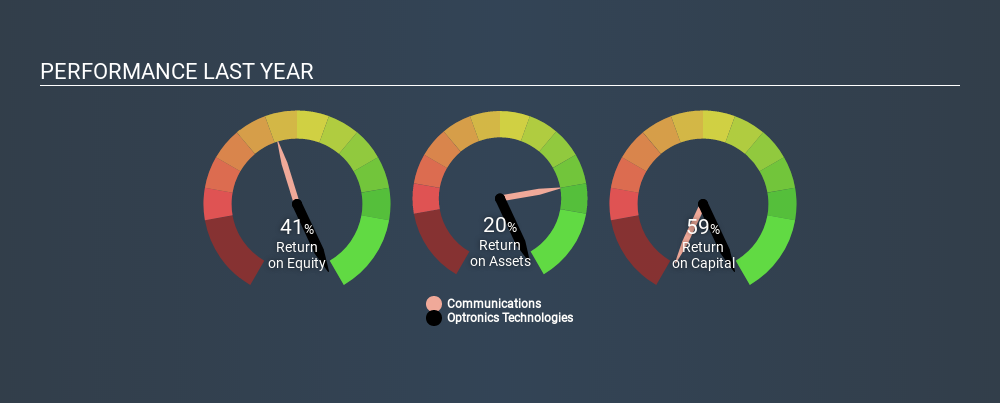
Today we are going to look at Optronics Technologies S.A. (ATH:OPTRON) to see whether it might be an attractive investment prospect. Specifically, we'll consider its Return On Capital Employed (ROCE), since that will give us an insight into how efficiently the business can generate profits from the capital it requires.
First up, we'll look at what ROCE is and how we calculate it. Second, we'll look at its ROCE compared to similar companies. Then we'll determine how its current liabilities are affecting its ROCE.
Return On Capital Employed (ROCE): What is it?
ROCE measures the 'return' (pre-tax profit) a company generates from capital employed in its business. Generally speaking a higher ROCE is better. Ultimately, it is a useful but imperfect metric. Renowned investment researcher Michael Mauboussin has suggested that a high ROCE can indicate that 'one dollar invested in the company generates value of more than one dollar'.
How Do You Calculate Return On Capital Employed?
Analysts use this formula to calculate return on capital employed:
Return on Capital Employed = Earnings Before Interest and Tax (EBIT) ÷ (Total Assets - Current Liabilities)
Or for Optronics Technologies:
0.59 = €1.7m ÷ (€5.8m - €3.0m) (Based on the trailing twelve months to June 2019.)
Therefore, Optronics Technologies has an ROCE of 59%.
See our latest analysis for Optronics Technologies
Is Optronics Technologies's ROCE Good?
When making comparisons between similar businesses, investors may find ROCE useful. In our analysis, Optronics Technologies's ROCE is meaningfully higher than the 12% average in the Communications industry. I think that's good to see, since it implies the company is better than other companies at making the most of its capital. Setting aside the comparison to its industry for a moment, Optronics Technologies's ROCE in absolute terms currently looks quite high.
Optronics Technologies has an ROCE of 59%, but it didn't have an ROCE 3 years ago, since it was unprofitable. This makes us wonder if the company is improving. You can click on the image below to see (in greater detail) how Optronics Technologies's past growth compares to other companies.

When considering ROCE, bear in mind that it reflects the past and does not necessarily predict the future. ROCE can be deceptive for cyclical businesses, as returns can look incredible in boom times, and terribly low in downturns. ROCE is, after all, simply a snap shot of a single year. How cyclical is Optronics Technologies? You can see for yourself by looking at this free graph of past earnings, revenue and cash flow.
How Optronics Technologies's Current Liabilities Impact Its ROCE
Short term (or current) liabilities, are things like supplier invoices, overdrafts, or tax bills that need to be paid within 12 months. The ROCE equation subtracts current liabilities from capital employed, so a company with a lot of current liabilities appears to have less capital employed, and a higher ROCE than otherwise. To counteract this, we check if a company has high current liabilities, relative to its total assets.
Optronics Technologies has current liabilities of €3.0m and total assets of €5.8m. Therefore its current liabilities are equivalent to approximately 52% of its total assets. Optronics Technologies's high level of current liabilities boost the ROCE - but its ROCE is still impressive.
What We Can Learn From Optronics Technologies's ROCE
So to us, the company is potentially worth investigating further. There might be better investments than Optronics Technologies out there, but you will have to work hard to find them . These promising businesses with rapidly growing earnings might be right up your alley.
If you like to buy stocks alongside management, then you might just love this free list of companies. (Hint: insiders have been buying them).
If you spot an error that warrants correction, please contact the editor at editorial-team@simplywallst.com. This article by Simply Wall St is general in nature. It does not constitute a recommendation to buy or sell any stock, and does not take account of your objectives, or your financial situation. Simply Wall St has no position in the stocks mentioned.
We aim to bring you long-term focused research analysis driven by fundamental data. Note that our analysis may not factor in the latest price-sensitive company announcements or qualitative material. Thank you for reading.
About ATSE:OPTRON
Optronics Technologies
Provides services in the fiber optics, optoelectronics, and laser applications markets in Greece.
Flawless balance sheet low.
Market Insights
Community Narratives





